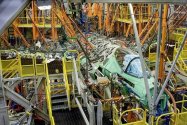well, I do remember the news you mentioned about some advanced technology FC-31 used, but I think back then the picture came with that news is rather a very big picture of the fuselage mainframe, rather the whole thing.The FC-31 project is partially a demonstrator for new manufacturing and production techniques. One of the innovations is that the whole fuselage skeleton from wing to wing is one fused single piece. If I recall correctly this is supposed to help improve the strength to weight ratio of the airframe, allowing for it to be lighter. The first FC-31 airframe we saw, all the way back in 2013 was shipped as a whole single piece, for this reason, so it follows that an iteration on that design would be handled similarly. There have been various articles of evidence talking about how the FC-31 put together. It’s even been briefly touched on in a documentary that talked about production improvements at SAC. Unless someone has aggregated these sources or kindly chooses to do this for you though, you’re going to have to dig around the forum archives.
But I could be wrong because something else I vaguely remember is that CAC used 3D print to build super-large titanium-alloy frame for J-20 or something...

